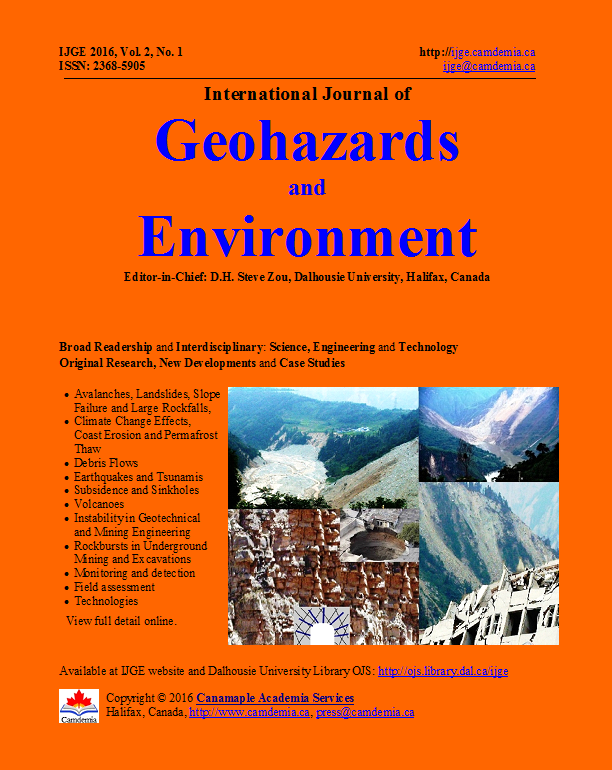In-Situ Stress Estimation by Back Analysis Based on Wellbore Deformation with Consideration of Pore Pressure
DOI:
https://doi.org/10.15273/ijge.2016.01.002Keywords:
in situ stresses, wellbore, back-analysis, diametrical deformation, constitutive modelAbstract
In oil and gas industry, wellbore stability control is paramount in an operation. It is essential to have information of the in situ stresses in well planning and prevention of wellbore failure. However, the current available measurement methods for in situ stresses in petroleum engineering are costly and often give scattering results. In this paper, a more practical displacement-based back analysis technique is proposed to determine the magnitude and orientation of the in situ stresses. The purpose is to provide an alternative tool for small operators in petroleum industry. An analytical solution is derived from displacement-stress relationship around a well in an isotropic rock with consideration of pore pressure. This method can be applied to calculate the displacement at any point around the well induced by drilling. In a reversed order, it can be used to calculate the in situ stresses from measured displacements at a number of locations on the borehole wall. For practical purpose, drained and undrained constitutive 2D models using measured diametrical deformation at different locations around a borehole wall as the input data have been developed to estimate the in situ stresses. Program codes in Matlab were written to facilitate the analysis under different conditions. An example is introduced to test the model and the program. The results validated this back-analysis approach and made a reliable estimation of the in situ stresses. The effects of pore pressure are also evaluated and are found to have significant impact on the shape of wellbore deformation. This impact differs for the drained and undrained conditions.Downloads
Published
Issue
Section
License
Copyright, Terms and Conditions
The International Journal of Geohazards and Environment (the Journal) is published by Canamaple Academia Services (the Publisher) online with open access, under a Creative Commons Attribution-Noncommercial license (CC-BY-NC) (http://creativecommons.org/licenses/by-nc/4.0/). Authors (the Authors) submitting papers (the Work) for publication in the Journal automatically agree to the following terms and conditions.
1. Under the license (CC-BY-NC), Authors give permission for others to share and reuse the Work, as long as the original source and author(s) are properly cited (i.e. a complete bibliographic citation and link to the Journal website) and the material is not used for commercial purposes. Any sharing or reuse must however indicate the original CC-BY-NC license terms of the work.
2. Authors transfer and assign to the Publisher all copyright in and to the Work. However Authors retain all proprietary rights except the copyright, related to the Work and also retain the rights a) to use, reproduce, distribute, and publicly display the Work in any medium in connection with the Authors‘ academic and professional activities, such as teaching, presentations and lectures, b) to create derivative works from the Work and to make full use of the Work in future research and publications, c) to authorize others to make any non-commercial use of the Work, d) to make both the pre-published and final-published versions available online in institutional and/or disciplinary repositories or on their own websites with a citation and link to the original paper published in the Journal.
3. Authors warrant that the Work is their original work, it is not copied from anywhere or anyone else, they are totally responsible for the authenticity, originality, validity and accuracy, and the facts and views are their own, that the Work contains no matter which is defamatory or infringes any literary or proprietary rights, intellectual property rights, or any rights of privacy, and that the Work has not been simultaneously submitted to any other journals or publishers. Authors further agree that their manuscripts whether accepted or rejected will not be returned and the rejected manuscripts will be disposed at the journal editor's discretion.
Disclaimer: The Publisher, the Journal and the editors accept no responsibility for statements or opinions expressed by authors. Use of information and materials in the Journal is the sole responsibility of users.


